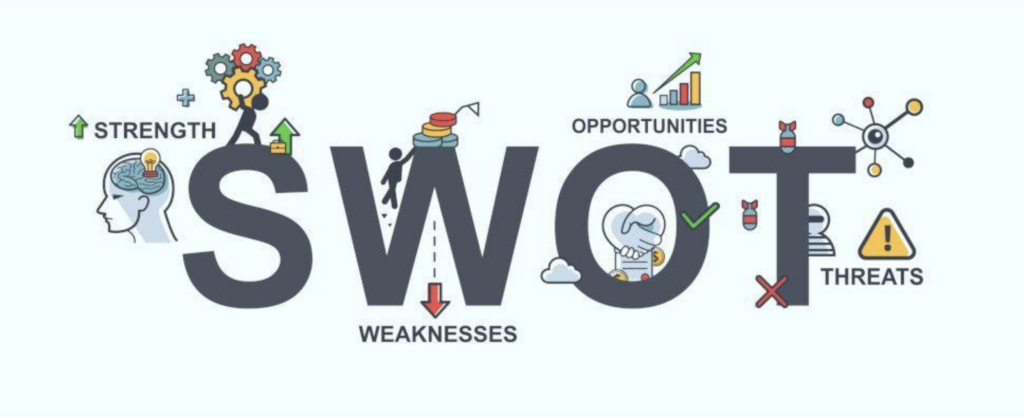SWOT analysis, a cornerstone of strategic planning, has been widely adopted by organisations due to its simplicity, versatility, and comprehensive perspective. Originating in the 1960s and popularised by Albert S. Humphrey, SWOT analysis helps businesses evaluate internal strengths and weaknesses alongside external opportunities and threats. This framework provides a holistic view that supports strategic alignment, facilitating informed decision-making and driving innovation and growth. Its enduring relevance lies in its ability to help businesses identify competitive advantages, mitigate risks, explore new opportunities, and enhance decision-making processes, making it an essential tool in navigating today’s competitive landscape.
The essence of SWOT analysis
At the core of strategic planning, SWOT analysis serves as a guiding light, leading businesses through the complexities of the market terrain. But what makes it so effective in strategic planning? By examining strengths, weaknesses, opportunities, and threats, companies can devise a roadmap that not only addresses current challenges but also prepares for future obstacles. This proactive approach ensures that businesses are not merely reacting to market dynamics but are actively shaping their trajectory. By harnessing SWOT analysis, leaders can translate intricate information into actionable insights, fostering an environment conducive to innovation and attainable strategic objectives.
The 4 pillars of SWOT analysis
Delving into the essence of SWOT analysis, we uncover its foundational elements represented by four key pillars. Strengths represent internal assets driving business success, such as innovative technology or a strong brand identity. Conversely, weaknesses signify internal vulnerabilities that may hinder progress, such as operational inefficiencies or skill gaps among staff. Opportunities represent external chances for growth, like new market segments or technological advancements. Lastly, threats encompass external challenges, such as competitive pressures or evolving regulatory environments. Together, these pillars offer a comprehensive framework for businesses to evaluate their strategic position, transforming introspection and market analysis into actionable insights propelling progress.
Utilizing SWOT analysis goes beyond theory; it’s about applying it practically to shape strategies that fit real-world challenges. Let’s imagine a company with strong brand loyalty. How can this drive the creation of trendy products for new markets? And what about outdated systems—how can a business adopt modern tech to avoid obsolescence? Crafting a strategy that maximizes strengths, seizes opportunities, and tackles weaknesses and threats is key to moving forward. So, how can we ensure we’re not overlooking important details or getting stuck on one part of the analysis?
Common mistakes in SWOT Analysis
Embarking on the SWOT analysis journey requires careful thought. It’s easy to overlook important details, which can cloud your strategy. Have you checked each part of your analysis thoroughly to make sure you’re not missing anything? Sometimes, we focus too much on strengths and forget about weaknesses and threats. Are you giving all areas equal attention? It’s also common to get stuck on one part and ignore the rest. How will you make sure you’re looking at everything? If we don’t stay attentive in our analysis, we might miss important insights. How will you keep your SWOT analysis up-to-date and relevant? To avoid these mistakes, we need to dive deep and look at all aspects of our business. Bringing in different perspectives can help us see things we might miss.
SWOT analysis serves as a fundamental tool in strategic business innovation, offering a comprehensive assessment of strengths, weaknesses, external opportunities, and threats. This method transcends conventional analysis by providing a dynamic framework tailored to modern market complexities. As organisations navigate dynamic economic landscapes, SWOT analysis fosters a nuanced understanding of both internal capabilities and external market dynamics. By leveraging this strategic tool, businesses can proactively anticipate and navigate potential challenges, ensuring resilience and competitive advantage. In conclusion, SWOT analysis acts as a compass, guiding businesses towards innovative strategies and enduring excellence in the face of uncertainty.
